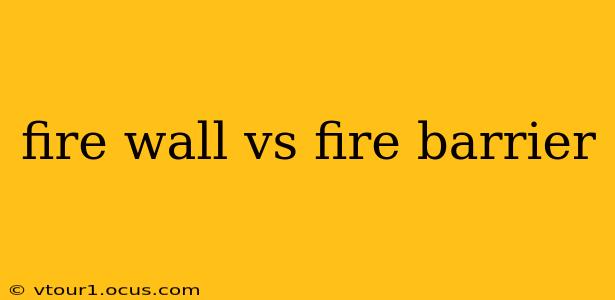Fire safety is paramount in any building, and understanding the distinctions between firewalls and fire barriers is crucial for ensuring adequate protection. While both aim to contain and control the spread of fire, they differ significantly in their design, purpose, and application. This comprehensive guide will clarify the key differences, helping you make informed decisions about fire safety in your building.
What is a Firewall?
A firewall is a robust, fire-resistant wall designed to prevent the spread of fire from one building to another, or from one section of a large building to another. Think of it as a major structural element, often extending from the foundation to the roof. It's built to withstand intense heat and flames for an extended period, significantly delaying or preventing fire transmission. Firewalls are typically constructed from materials like concrete, brick, or reinforced masonry, and their design adheres to strict building codes and fire safety regulations. They are frequently used in multi-building complexes, large industrial facilities, and high-rise structures.
Key Characteristics of Firewalls:
- High fire resistance rating: Measured in hours, this rating indicates how long the wall can withstand fire exposure without compromising its structural integrity.
- Independent structural support: Firewalls are typically self-supporting, meaning they don't rely on adjacent structures for stability.
- Penetration control: Any penetrations (e.g., pipes, conduits, doors) through the firewall must be carefully sealed and fire-rated to maintain its effectiveness.
- Extensive design and construction: Firewalls require specialized engineering and construction expertise due to their complex design and stringent safety requirements.
What is a Fire Barrier?
A fire barrier, on the other hand, is a less substantial fire-resistant element designed to restrict the spread of fire within a single building. Unlike a firewall, a fire barrier does not need to be a full-height, load-bearing wall. It can be constructed from various materials, including drywall, fire-rated gypsum board, or other fire-resistant assemblies. Its primary function is to compartmentalize a building, limiting the spread of smoke and flames to specific areas, allowing for easier evacuation and firefighting efforts.
Key Characteristics of Fire Barriers:
- Lower fire resistance rating: Compared to firewalls, fire barriers generally have shorter fire resistance ratings, often measured in minutes or a single hour.
- Less robust construction: Fire barriers can be lighter and less structurally demanding than firewalls, often incorporating less substantial materials.
- Various applications: They are used extensively to separate different occupancy areas within a building, such as apartments, offices, or storage rooms.
- Specific design requirements: Fire barriers still adhere to building codes and fire safety standards, but their design flexibility allows for a broader range of applications.
Firewall vs. Fire Barrier: A Comparison Table
| Feature | Firewall | Fire Barrier |
|---|---|---|
| Purpose | Prevent fire spread between buildings or major sections of a building | Restrict fire spread within a building |
| Construction | Robust, usually masonry or concrete | Less robust, various materials possible |
| Fire Rating | High (several hours) | Lower (minutes to one hour) |
| Structural Role | Often load-bearing | Usually not load-bearing |
| Application | Multi-building complexes, large facilities | Single buildings, compartmentalization |
What are the differences in the regulations and building codes for firewalls and fire barriers?
Building codes vary by location, but generally, firewalls have stricter regulations concerning construction, materials, and fire resistance ratings than fire barriers. Firewalls require more detailed engineering plans and inspections to ensure their structural integrity and ability to withstand intense fire exposure for extended periods. Fire barriers, while still subject to building codes, have more flexibility in their design and construction materials, provided they meet the specified fire-resistance rating.
What are some examples of where firewalls and fire barriers are used?
Firewalls: Large industrial plants, hospitals, high-rise apartment complexes, schools, and commercial buildings with distinct sections.
Fire Barriers: Apartment buildings (separating individual units), office buildings (separating departments), hotels (separating guest rooms and corridors), and retail spaces (separating different stores within a mall).
This detailed comparison should help clarify the distinctions between firewalls and fire barriers. Remember, consulting with a qualified fire safety professional is crucial for determining the appropriate fire protection measures for your specific building and location. Ignoring fire safety can have devastating consequences. Prioritizing safety through proper design and implementation is a vital investment.
